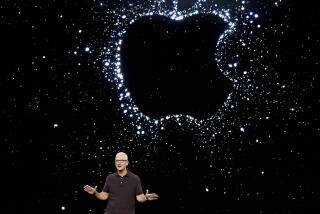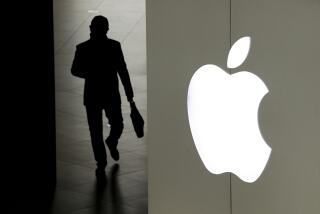Rivals IBM, Apple Will Exchange Technologies : Computers: Accord could alter industry’s balance of power. A key aim is to drive out foreign-made clones.
High-tech pioneers and former arch-rivals Apple Computer and IBM Corp. on Wednesday unveiled plans for a high-stakes technology swap that could alter the balance of power in the computer industry while complicating the already dizzying array of choices facing consumers and businesses.
At the same time, the pact could make easy-to-use desktop computers of the type pioneered by Apple’s revolutionary Macintosh model more readily available to corporations and their employees--but perhaps at prices considerably above those offered amid the current price-war environment.
The agreement is the most dramatic example yet of the growing movement by computer makers to cluster in rival business alliances, fortifying themselves in the increasingly fierce fight for customers.
The historic nature of the deal was underscored by analysts who described it as the business equivalent of a U.S.-Soviet friendship treaty for sharing military secrets. “This is the most unthinkable alliance that became thinkable in a very short time,” said Sam Albert, who heads a computer consulting firm in Scarsdale, N.Y.
Under terms of the agreement, not expected to become final for several months, broad-ranging desktop computer technology from both companies would be combined into standardized packages that would be manufactured by both Apple and IBM as well as other selected companies.
In addition, the deal calls for the creation of a new company, jointly owned by Apple and IBM, to write a new type of easy-to-use computer software, and the integration of Apple’s Macintosh computer design into IBM systems.
Although potentially boggling to the technologically uninitiated, analysts said the goal of the pact is not to create a revolutionary new desktop computer technology.
Rather, they said, the aim is to create a market force of acknowledged industry titans that will lead the industry away from cheap, foreign-made clones toward products that will produce greater profits for their makers--namely IBM and Apple, two of the computer makers hardest hit in the current downturn. The clones are produced in countries such as Taiwan and South Korea.
“Make no mistake about it. This is a market share war posing as a technology upheaval,” said Richard Shaffer, publisher of a computer industry newsletter. “It’s really all about money.”
Potential losers from the deal include Microsoft and Intel, two of the biggest and most important players in today’s personal computer industry.
Microsoft, the world’s largest personal computer software publisher, supplies for IBM personal computers and their clones the now dominant MS-DOS and Windows operating system software--the sets of instructions that tell a computer how to handle information. Intel currently supplies the microprocessor, or computer brain-on-a-chip, that controls IBM personal computers and compatible machines. Under terms of the Apple-IBM pact, Motorola will supply the preferred microprocessor.
According to Shaffer, IBM and Apple have both been particularly hard hit by the ready availability of low-cost personal computers, modeled after the IBM PC, that use both Microsoft operating system software and Intel microprocessors.
IBM has seen its share of the personal computer market--still the fastest growing in the entire computer industry--dwindle under intense competition from such clone makers as Dell Computer, AST Research and low-cost, offshore manufacturers.
While Apple has not faced direct competition from low-cost clone makers, the easy availability of cheap PCs forced the company last year to unveil a low-cost Macintosh. That move was blamed in part for Apple’s recent huge drop in profits and the resulting decision to lay off about 1,500 workers this month.
“PC clones are setting the price points for the computer world,” Shaffer said. “If you don’t get rid of the clone makers by setting a new set of technology standards, then you will never be able to take control of your profit margins again.”
But the goal is not to get rid of all clone makers.
Together Apple and IBM control about 40% of the desktop computer market, analysts said, giving the new joint venture a potentially huge share of the market even without the backing of other manufacturers. That large clout, analysts said, should enable the IBM-Apple joint venture to selectively pick which manufacturers to allow to make compatible models.
And analysts said they could be quite sure that cheap, knock-off manufacturers, who today can get everything they need from Intel and Microsoft, would not be readily accepted by the new venture.
“Microsoft is no longer in the driver’s seat,” said Tim Bajarin, an analyst at Creative Strategies in Santa Clara. “This represents a potentially huge shift in power for the entire industry.”
Microsoft President Michael Hallman said the software publisher would take a “wait-and-see” approach to the new deal, noting that it’s a “long way from a letter of intent to a new company with a new operating system that’s as sweeping as the one proposed here.”
However, Hallman said, the pact clearly underscored the reasons for the recent rift between Microsoft and IBM by demonstrating how differently the two companies view the personal computer market.
“We believe the PC market has been so successful--with 70 million users--precisely because it’s been so competitive and open to so many participants,” Hallman said. “If this deal wants to change that, then I believe the market is sophisticated enough to reject any effort to raise prices.”
Joseph Krovisky, a Justice Department spokesman, said in Washington that the department is evaluating the IBM-Apple announcement for possible antitrust consequences.
However, some attorneys said they did not see any potential anti-competitive threat, noting that a number of leaders in the computing field have formed alliances to promote industry standards and protect themselves from foreign competition.
“No one company can be equally strong in everything,” said Jack E. Brown, a Phoenix-based lawyer who has handled copyright and antitrust matters for a number of computer makers. “The kind of limited cooperation in terms of technology represented here is the kind of thing that’s easily tolerated among world players.”
Analysts have said they expect to see more cooperative relationships among computer companies because the industry is maturing and no single company has the financial and technological resources to develop major products alone.
Earlier this year, Compaq Computer, Microsoft and Mips Computer Systems spearheaded the creation of a similar, but rival, alliance. IBM alone has made three considerably smaller pacts with industry members Wang Laboratories, Borland International and Lotus Development in just the last two weeks.
IBM-Apple Deal at a Glance
Here is a rundown of the agreement announced by International Business Machines and Apple Computer in which they will share important technologies and create new products:
Apple and IBM will form a venture that will develop software to be sold by both companies. The software, a direct challenge to industry leader Microsoft Corp., will offer new functions and simplify the programming process from laptops to large computers. The software will run on major industry hardware systems based on a fast new breed of computer chips.
Apple’s easy-to-use Macintosh computer design will be integrated into IBM’s systems. The companies will develop and sell products that will further extend the ability of the Macintosh to run on IBM systems. They will also combine the strengths of IBM and Apple technology to develop and market an enhanced operating system, the underlying program that controls a computer and makes it possible for users to enter and run their own programs.
Motorola Inc. and IBM will make a new family of computer chips for IBM’s RISC-6000 POWER system, used on its workstations, which are extremely powerful desktop computers. Motorola will provide the chips to IBM, Apple and others. Apple will adopt IBM’s RISC-6000 architecture in future Macintosh personal computers.
RELATED STORY: D1






